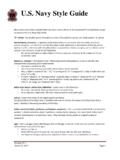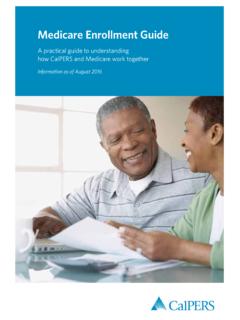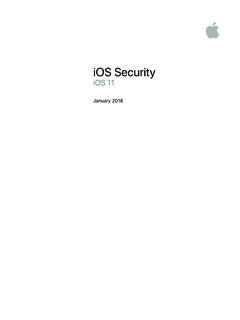Transcription of Guide for Cybersecurity Event Recovery
1 NIST Special Publication 800-184 Guide for Cybersecurity Event Recovery Michael Bartock Jeffrey Cichonski Murugiah Souppaya Matthew Smith Greg Witte Karen Scarfone This publication is available free of charge from: C O M P U T E R S E C U R I T Y NIST Special Publication 800-184 Guide for Cybersecurity Event Recovery Michael Bartock Jeffrey Cichonski Murugiah Souppaya Applied Cybersecurity Division Computer Security Division Information Technology Laboratory Information Technology Laboratory Matthew Smith Karen Scarfone Greg Witte Scarfone Cybersecurity G2, Inc. Clifton, VA Annapolis Junction, MD This publication is available free of charge from: December 2016 Department of Commerce Penny Pritzker, Secretary National Institute of Standards and Technology Willie May, Under Secretary of Commerce for Standards and Technology and Director Authority This publication has been developed by NIST in accordance with its statutory responsibilities under the Federal Information Security Modernization Act (FISMA) of 2014, 44 3551 et seq.
2 , Public Law ( ) 113-283. NIST is responsible for developing information security standards and guidelines, including minimum requirements for federal information systems, but such standards and guidelines shall not apply to national security systems without the express approval of appropriate federal officials exercising policy authority over such systems. This guideline is consistent with the requirements of the Office of Management and Budget (OMB) Circular A-130. Nothing in this publication should be taken to contradict the standards and guidelines made mandatory and binding on federal agencies by the Secretary of Commerce under statutory authority. Nor should these guidelines be interpreted as altering or superseding the existing authorities of the Secretary of Commerce, Director of the OMB, or any other federal official.
3 This publication may be used by nongovernmental organizations on a voluntary basis and is not subject to copyright in the United States. Attribution would, however, be appreciated by NIST. National Institute of Standards and Technology Special Publication 800-184 Natl. Inst. Stand. Technol. Spec. Publ. 800-184, 53 pages (December 2016) CODEN: NSPUE2 This publication is available free of charge from: Certain commercial entities, equipment, or materials may be identified in this document in order to describe an experimental procedure or concept adequately. Such identification is not intended to imply recommendation or endorsement by NIST, nor is it intended to imply that the entities, materials, or equipment are necessarily the best available for the purpose.
4 There may be references in this publication to other publications currently under development by NIST in accordance with its assigned statutory responsibilities. The information in this publication, including concepts and methodologies, may be used by federal agencies even before the completion of such companion publications. Thus, until each publication is completed, current requirements, guidelines, and procedures, where they exist, remain operative. For planning and transition purposes, federal agencies may wish to closely follow the development of these new publications by NIST. Organizations are encouraged to review all draft publications during public comment periods and provide feedback to NIST.
5 Many NIST Cybersecurity publications, other than the ones noted above, are available at Comments on this publication may be submitted to: National Institute of Standards and Technology Attn: Computer Security Division, Information Technology Laboratory 100 Bureau Drive (Mail Stop 8930) Gaithersburg, MD 20899-8930 Email: All comments are subject to release under the Freedom of Information Act (FOIA).NIST SP 800-184 Guide FOR Cybersecurity Event Recovery ii This publication is available free of charge from: Reports on Computer Systems Technology The Information Technology Laboratory (ITL) at the National Institute of Standards and Technology (NIST) promotes the economy and public welfare by providing technical leadership for the Nation s measurement and standards infrastructure.
6 ITL develops tests, test methods, reference data, proof of concept implementations, and technical analyses to advance the development and productive use of information technology. ITL s responsibilities include the development of management, administrative, technical, and physical standards and guidelines for the cost-effective security and privacy of other than national security-related information in federal information systems. The Special Publication 800-series reports on ITL s research, guidelines, and outreach efforts in information system security, and its collaborative activities with industry, government, and academic organizations. Abstract In light of an increasing number of Cybersecurity events, organizations can improve resilience by ensuring that their risk management processes include comprehensive Recovery planning.
7 Identifying and prioritizing organization resources helps to Guide effective plans and realistic test scenarios. This preparation enables rapid Recovery from incidents when they occur and helps to minimize the impact on the organization and its constituents. Additionally, continually improving Recovery planning by learning lessons from past events, including those of other organizations, helps to ensure the continuity of important mission functions. This publication provides tactical and strategic guidance regarding the planning, playbook developing, testing, and improvement of Recovery planning. It also provides an example scenario that demonstrates guidance and informative metrics that may be helpful for improving resilience of information systems.
8 Keywords cyber Event ; Cybersecurity ; Cybersecurity Framework (CSF); Cybersecurity National Action Plan (CNAP); Cybersecurity Strategy and Implementation Plan (CSIP); metrics; planning; Recovery ; resilience NIST SP 800-184 Guide FOR Cybersecurity Event Recovery iii This publication is available free of charge from: Acknowledgments The authors wish to thank their colleagues from NIST and organizations in the public and private sectors who contributed comments at the NIST workshops, reviewed drafts of this document, and contributed to its technical content. In particular, we wish to thank Andrew Harris and Mark Simos from Microsoft and Christopher Butera from US-CERT.
9 The authors would also like to acknowledge Jon Boyens, Sean Brooks, Jim Foti, Naomi Lefkovitz, and Adam Sedgewick of NIST. Trademark Information All trademarks or registered trademarks belong to their respective organizations. NIST SP 800-184 Guide FOR Cybersecurity Event Recovery iv This publication is available free of charge from: Table of Contents Executive Summary .. vi 1. Introduction .. 1 Background .. 1 Purpose and Scope .. 2 Audience .. 2 Document Structure .. 3 2. Planning for Cyber Event Recovery .. 4 Enterprise Resiliency .. 4 Recovery Planning Prerequisites .. 6 Recovery Plan .. 7 Planning Document Development .. 7 Process and Procedure Development.
10 9 Determination of Recovery Initiation/Termination Criteria and Goals .. 10 Root Cause and Containment Strategy Determination .. 10 Recovery Communications .. 11 Sharing Recovery Insights .. 12 Summary of Recommendations .. 13 3. Continuous Improvement .. 15 Validating Recovery Capabilities .. 15 Improving Recovery and Security Capabilities .. 16 Summary of Recommendations .. 18 4. Recovery Metrics .. 19 5. Building the Playbook .. 21 6. An Example of a Data Breach Cyber Event Recovery Scenario .. 24 Pre-Conditions Required for Effective Recovery .. 24 Tactical Recovery Phase .. 25 Initiation .. 25 Execution .. 26 Termination .. 28 Strategic Recovery Phase.



















